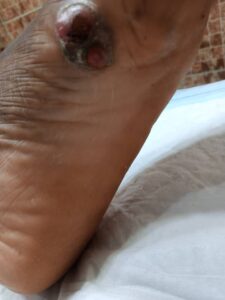

Tumours are groups of abnormal cells that form lumps or growths. They can start in any one of the trillions of cells in our bodies. Tumours grow and behave differently, depending on whether they are cancerous (malignant), non-cancerous (benign) or precancerous.
A malignant skin tumuor is cancerous and therefore, often regarded as skin cancer
Functions of the skin:
The skin is the body’s largest organ. It protects the body against infection and injury and helps regulate body temperature. The skin also stores water and fat and produces vitamin D.
There are three main types of tumor:
Benign: These are not cancerous. They either cannot spread or grow, or they do so very slowly. If a doctor removes them, they do not generally return.
Premalignant: In these tumors, the cells are not yet cancerous, but they have the potential to become malignant.
Malignant: Malignant tumors are cancerous. The cells can grow and spread to other parts of the body.
It is not always clear how a tumor will act in the future. Some benign tumors can become premalignant and then malignant. For this reason, it is best to monitor any growth.
Causes of skin tumour and malignancy (cancerous cell)
Most malignancy i.e. cancerous cells occur due to sudden changes in the DNA of the site cells, so also is the skin malignancy (cancer). It occurs when errors (mutations) occur in the DNA of skin cells. The mutations cause the cells to grow out of control and form a mass of cancer cells.
Another cause is unguided and often exposure to ultraviolet (UV) light. Failure to protect the skin, the UV light may cause DNA abreaction which might turn out worse.
Predisposing (risk) factors to skin tumour and malignancy
Factors that may increase your risk of skin cancer include:
- Fair skin: Having less pigment (melanin) in your skin provides less protection from damaging UV radiation. If you have blond or red hair and light-colored eyes, and you freckle or sunburn easily, you’re much more likely to develop skin cancer than a person with darker skin.
- A history of sunburns: Having had one or more blistering sunburns as a child or teenager increases your risk of developing skin cancer as an adult. Sunburns in adulthood also are a risk factor.
- Excessive sun exposure: Anyone who spends considerable time in the sun may develop skin cancer, especially if the skin isn’t protected by sunscreen or clothing.
- Moles: People who have many moles or abnormal moles called dysplastic nevi are at increased risk of skin cancer.
- Precancerous skin lesions: Having skin lesions known as actinic keratoses can increase your risk of developing skin cancer.
- A family history of skin cancer: If one of your parents or a sibling has had skin cancer, you may have an increased risk of the disease or it may be a personal history of skin cancer.
- A weakened immune system: People with weakened immune systems have a greater risk of developing skin cancer. This includes people living with HIV/AIDS and those taking immunosuppressant drugs after an organ transplant.
- Exposure to radiation: People who received radiation treatment for skin conditions such as eczema and acne may have an increased risk of skin cancer, particularly basal cell carcinoma.
Prevention of skin tumour and malignancy
Health is wealth as prevention is better than cure, most skin malignancies are preventable. To protect yourself, follow these skin cancer prevention tips:
- Avoid the sun during the middle of the day
- Wear sunscreen year-round.
- Wear protective clothing.
- Avoid tanning beds. Lights used in tanning beds emit UV rays and can increase your risk of skin cancer.
- Be aware of sun-sensitizing medications.
- Check your skin regularly and report changes to your doctor.




Recent Comments